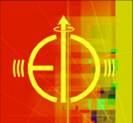 Electron-Ion Collider Collaboration
Electron-Ion Collider Collaboration 
The Electron-Ion Collider Collaboration
Welcome
This is the home page of the Electron-Ion Collider Collaboration (EICC). EICC consists of more than 100 physicists from over 20 laboratories and universities from around the world who are working to realize a powerful new facility in the United States with the aim of studying the particles (gluons) which bind all the observable matter in the world around us. This new facility, known as the Electron-Ion Collider (EIC), would collide intense beams of spin-polarized electrons with intense beams of both polarized nucleons and unpolarized nuclei from deuterium to uranium. Large, new detectors are being designed to detect the high-energy scattered particles as well as the low-energy debris as a means to definitively understand how the matter we are all made of is bound together.
EIC Science
As discussed in the White Paper prepared for the 2007 Nuclear Physics Long-Range Plan, the EIC will address compelling physics questions essential for understanding the fundamental structure of matter:
- Precision imaging of the sea-quarks and gluons to determine the spin, flavor and spatial structure of the nucleon;
- Definitive study of the universal nature of strong gluon fields in nuclei.
Without gluons there are no protons, no neutrons, and no atomic nuclei. Interactions among gluons determine the unique features of strong interactions. However, gluon properties in matter remain largely unexplored. Recent theoretical breakthroughs and experimental results suggest that both nucleons and nuclei when viewed at high energies appear as dense systems of gluons, creating the strongest fields in nature. The emerging science of this universal gluonic matter drives the development of a next-generation high luminosity electron-ion collider. Polarized beams in the EIC will give unprecedented access to the spatial and spin structure of gluons in the proton. The EIC embodies the vision of the U.S. nuclear physics community for reaching the next QCD frontier. Realization of an EIC will require advancements in accelerator science and technology, detector R&D, and continued theoretical development.
The 2007 U.S. Nuclear Physics Long Range Plan has recently recommended the allocation of resources to develop accelerator and detector technology necessary to lay the foundation for a polarized Electron-Ion Collider. Accelerator physicists at Brookhaven National Laboratory, Thomas Jefferson Laboratory and the Massachusetts Institute of Technology are actively working on the design of the high-energy, high-luminosity EIC.
EICC is open to all physicists who will work to achieve the goals of the EIC collaboration.
EIC Goals
The EIC Collaboration has been formed with the following goals:
- to develop the most compelling science case for a high luminosity electron-ion collider (EIC) independent of where this accelerator may be sited,
- to work with accelerator physicists, particularly at Brookhaven National Laboratory, Upton, New York and Thomas Jefferson National Accelerator Facility, Newport News, Virginia to develop the optimal EIC accelerator design, and
- to design and realize through a program of R&D the optimal suite of detectors for EIC.
EICC welcomes new members from around the world. All physicists interested in joining should contact Abhay Deshpande at abhay@bnl.gov or Richard Milner at milner@mit.edu.
EIC Activities
The EICC is actively working on the development of the science case using computer simulations and the design of the accelerators and detectors to carry out the measurements (see the relevant links to the left).
EIC Meetings
The first EICC meeting was held April 6-7, 2007 at MIT followed by the meetings